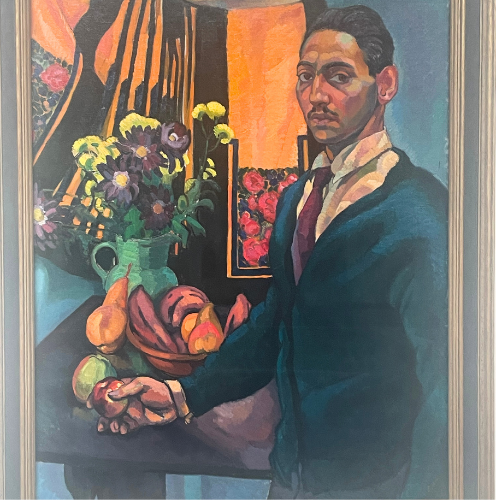
Lee Simonson, Self-Portrait, c. 1912, oil on canvas, National Portrait Gallery, Smithsonian Institution


© 2025 Matisse's Flowers. All rights reserved.
A Fauvist Self-Portrait
Inspired by Lee Simonson’s Self Portrait, 1912
This painting from 1912 by Lee Simonson is on view at the National Portrait Gallery in Washington, DC.
🎨 The Artist: Lee Simonson
Lee Simonson wasn’t just a painter—he was a visionary in theater design. Passionate about the power of visual storytelling, he explored how painters’ and designers’ vision could revitalize the stage. In 1912, at just 24 years old, Simonson painted Self-Portrait after returning from Paris, where he had encountered experimental theater and the work of groundbreaking modern artists. This portrait feels like a statement of ambition—a young artist capturing not just who he was, but who he wanted to become as he launched his career in theater set design and architecture.
🖼 The Work: A Fauvist Influence
Simonson’s self-portrait is infused with the energy of Fauvism, a movement led by artists like Henri Matisse. The name “Fauves” (French for “wild beasts”) was given by an art critic who found their use of vivid colors, expressive brushstrokes, and decorative abstraction too radical at the time. But for a theater designer like Simonson, Fauvism was a natural fit—after all, what is stage design if not a bold play of color, shape, and spectacle? His portrait reflects this theatricality, embracing dramatic tones and gestural strokes that feel alive, almost like a scene set for the stage.
💐 The Florals: A Bold, Complementary Palette
To capture the expressive intensity of Fauvism, I turned to florals with saturated, dramatic hues. I chose maroon dahlias, waiting a few days past their peak so their yellow pollen centers would emerge—a perfect nod to the contrast and energy of Simonson’s brushwork. For additional yellow highlights, I used daisies and goldenrod, playing with color theory to create a striking balance. Purple and yellow are complementary colors, making this arrangement feel just as bold and deliberate as Simonson’s self-portrait. The result? A floral composition that echoes the same vibrancy, depth, and wild spirit as Fauvism itself.
✨ Fun Fact: Stage Meets Canvas
While Simonson is best known for his contributions to modern stage design, he also explored painting and writing. He believed that theater could learn from painting—and vice versa—showing how different artistic disciplines could inspire and reinvent one another. His Fauvist self-portrait isn’t just a painting; it’s a theatrical performance in color.
Sources:
(1) Simon, S. The brush: An exhibition of American paintings [Exhibition webpage]. National Portrait Gallery. https://npg.si.edu/exh/brush/simon.htm.
(2) Britannica, T. Editors of Encyclopaedia. "Fauvism." Encyclopedia Britannica, August 7, 2024. https://www.britannica.com/art/Fauvism.